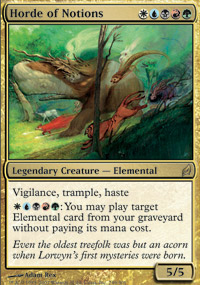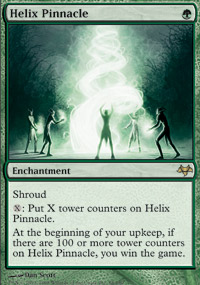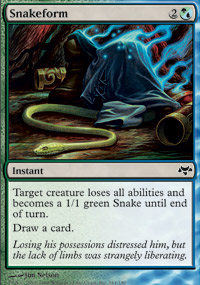
Cranial Insertion
Bring Your Aspirin
By Eli Shiffrin, Tom Fowler, and Diane Colley
Bring Your Aspirin
By Eli Shiffrin, Tom Fowler, and Diane Colley
Willkommen, bienvenue, and welcome to another installment of Cranial Insertion! Make yourself comfortable and open your mind. Moko pulled no punches this week when selecting your questions for the article, so we’ve got some fairly intense ones. This article is not for the faint of heart or layer-phobic. On top of that the Comprehensive Rules just got a whole new rule 407! We’ll cover that in this article as well. No rest for the wicked, and all that jazz.
Keep the questions coming to [email]cranial.insertion@gmail.com[/email]!
And now, without further slow play, let the questions begin!

For The Horde!
Q: With Gaddock Teeg in play, can I still use Horde of Notions' ability on non-creature elementals with converted mana costs higher than 4 in my graveyard?
A: No. Horde of Notions allows you to play cards from the graveyard without paying their mana costs, but it still makes you play them. It does not magically put them onto the stack with all their modes and targets chosen. THIS IS NOT MAGIC. Okay, well, maybe it is. But no, you can’t do that.
Q: With two Mana Reflections under my control, how much mana can I get with an Island and a Sunken Ruins?
A: Assuming you tap the Island and put one of the mana from it into the Sunken Ruins, you’ll get a total of 11 mana out of the whole deal. It’ll be your choice of , , or . Each Mana Reflection has a replacement effect that wants to apply to the mana made by each land. First, the Island tries to make its normal . Then, one of the Mana Reflections (your choice which one, if it matters) will apply, making it produce twice that much mana, or . Then, the second Mana Reflection applies, doubling the to . When you spend one of those four on the Sunken ruins, the same thing happens again. You’ll double the mana you choose to make with the Sunken Ruins, then double it again.
Quote fromIf two or more replacement or prevention effects are attempting to modify the way an event affects an object or player, the affected object's controller (or its owner if it has no controller) or the affected player chooses one to apply. Then the other effect applies if it is still appropriate.
Q: With Prismatic Omen and 5 lands in play, I cast Last Stand and target my opponent's Essence Warden with the damage. Will he still gain the life for my saprolings coming into play?
A: Yes. Even though the instructions on the card will be carried out in the order they are written, state-based effects will not have a chance to kill off the lethally-damaged Essence Warden until after Last Stand has fully resolved. By that point, it will have triggered for your 5 saprolings. This is different from a card that instructs you to destroy or sacrifice a creature, because that will happen as part of the resolution of the spell, not at the hands of the next SBE check.
Q: I control Nobilis of War and two kithin tokens. If I cast Mirrorweave targeting my Nobilis, then cast Springjack Shepherd, how many goat tokens will I get?
A: You will get a herd of 16 goats. Hybrid symbols count for chroma of either of the colors they contain, and Mirrorweave will copy the mana cost of the Nobilis onto the kithkin tokens.
Quote fromWhen copying an object, the copy acquires the copiable values of the original object's characteristics (name, mana cost, color, card type, supertype, subtype, expansion symbol, rules text, power, toughness, loyalty).

Johnnys do it
With tower counters.
A: You’ll get x additional counters. This trick works, and I encourage using it. Helix Pinnacle may in fact be The Most Awesome Card In Eventide. If Helix Pinnacle were worded “: Put a tower counter on Helix Pinnacle,” you would have to activate it x separate times to put x counters on it. However, with the way it is worded, you only have to activate it once to put x counters on it, so that activation can be copied for mass amounts of Win.
Now pair it up with Seedborn Muse, Doubling Season, and Mana Reflection for some serious Towering. Winning with tower counters is probably the most badass, manly way to win a game of Magic. Seriously. How many (not-silver-bordered) cards have 3-digit integers in their text boxes? Battle of Wits and Helix Pinnacle are the only ones I can think of.
[What would Freud say about Urchin? We’re somewhat afraid to know the answer to that. –Ed.]
Q: I have Horde of Notions in play and Wispmare in my graveyard. My opponent plays Oblivion Ring and targets my Horde of Notions with its comes into play ability. With its comes into play ability on the stack, can I bring back my Wispmare and keep him from O-Ringing my Horde?
A: No. You’re doing it wrong. If you do what you described, Oblivion Ring’s leaves play ability will be put on the stack on top of its comes into play ability, and that will resolve first. When the comes into play ability resolves, your Horde of Notions will be removed permanently. Your best bet is probably to let the Ring’s ability resolve and find some way to destroy it later.
Q: My opponent controls Raking Canopy. I attack with Kinscaer Harpoonist, choosing to make the Harpoonist lose flying. Will Raking Canopy deal damage to it?
A: Yes. When the Harpoonist attacks, both it and the Canopy trigger. Triggers will go on the stack in Active Player Non Active Player order, which means the Canopy’s trigger will resolve first. Even if it didn’t resolve first, it would already be on the stack, and Harpooning would do nothing to stop it from dealing 4 damage.
Quote fromIf multiple abilities have triggered since the last time a player received priority, each player, in APNAP order, puts triggered abilities he or she controls on the stack in any order he or she chooses.
Q: If I attack with my Nantuko Husk, then cast Temporal Isolation on it before blockers are declared, can I put damage on the stack, then sacrifice the Husk to itself to get the damage through?
A: Yes, your Husk haxx0rz work. Temporal Isolation will only prevent the damage if it is in play when the damage is dealt. Otherwise, it has no way of affecting it. Because you sacrificed the Husk with damage still on the stack, the Temporal Isolation will be in the graveyard before damage resolves. Tricksy, My Precious! Filthy Kithkin Baggins!
(Protip: the contents of your pocket is hidden information, so you’re not obligated to be truthful about it if asked. Bluff away.)
Q: I control a Disciple of Grace, which my opponent kills during my combat phase. In my second main phase, I cast Regrowth on it, then cycle it. If I then play Second Sunrise, will the Disciple return to play, since it was put into the graveyard that turn?
A: No, it will not. Whenever an object changes zones, the game sees it as a new object. Thus, the Disciple of Grace that is in the graveyard when you cast Second Sunrise came from your hand, not from play. It doesn’t remember that it was in play earlier that turn. The only things Second Sunrise will return are artifacts, creatures, and lands that were put into a graveyard this turn, and that have remained there continuously since.
Quote fromAn object that moves from one zone to another is treated as a new object.
Q: Regarding having artistic modifications on cards, would I be allowed to write “PICK ME!” on my Accumulated Knowledges so I remember to grab them with Intuition?
A: While the legality of modified cards is decision of the Head Judge, I’ll point out that the modification you described is in fact notes from outside the match, and thus punishable under Unsporting Conduct – Outside Assistance.
As far as artistic modifications go, the rule of thumb is that the card must still be recognizable by its art. Once again, it is the Head Judge’s discretion whether to allow a specific modification. Cards must also comply with other standards, such as being unmarked, inoffensive, and not having notes from outside the match written on them.
Q: What is all this Linked Ability business? An entire new section of rules appeared in 407!
A: Haha! You read Comprehensive Rules updates? You’re a geek. Seriously. Only rules column authors and judges read those, and how uncool are they? Wait a minute…
The new rule 407 means my Runed Halo, Mirrorweave, Opalescence, Meddling Mage shenanigans don’t work. (Wizards must have one of its special operatives watching this column, and they detected my plot to prevent Islands from being played. I may have been subverted this time, but one day, ONE DAY, I will ban a basic land. Just you wait.)
Oh, and the new 407 does other stuff too. It means that when a card asks for a choice with one ability, then later references that choice with another ability, the two abilities are “linked,” and that choice can only be used for the ability with which it is linked. In other words, Mirrorweaving a Voice of All into a Chameleon Spirit will not let you keep the choice you made for Voice of All, because the ability that let you choose a color is not linked to the characteristic-defining ability of the Voice-turned-Chameleon Spirit. In such cases where you never made a choice, the choice is considered to be undefined. Undefined powers and toughnesses of creatures are considered to be 0.
Quote fromIf an object has an ability printed on it that causes a player to "choose a [value]" or "name a card," and another ability printed on it that refers to "the chosen [value]," "the last chosen [value]," or "the named card," these abilities are linked. The second ability refers only to a choice made as a result of the first ability.
407 also means that if you find some way to give a Jester's Scepter another card-removing ability (March of the Machines, Scrabbling Claws, and Mirrorweave, to cite one of the multitudinous and extraordinarily common examples) the cards you remove with that ability will not be usable for its activated ability (once Mirrorweave wore off), since only the Scepter’s triggered ability is linked to its activated ability, not the scrabbling ability it “borrowed” for the turn.
Quote fromIf an object has an activated or triggered ability printed on it that removes one or more cards from the game, and another ability printed on it that refers either to "the removed cards" or to cards "removed from the game with [this object]," these abilities are linked. The second ability refers only to cards in the removed-from-the-game zone that were moved there as a result of the first ability.
407.2c does essentially the same thing as 407.2a, only for cards that put things into play. Think Tetravus. If you put Elemental Mastery on it, you will not be able to use the Elemental tokens to give Tetravus +1/+1 counters, because the Elemental Mastery ability is not linked to Tetravus’s second triggered ability. C-C-C-COMBO BREAKER!
Quote fromIf an object has an activated or triggered ability printed on it that puts one or more objects into play, and another ability printed on it that refers to objects "put into play with [this object]," those abilities are linked. The second can refer only to objects put into play as a result of the first.
407 has a few other parts, but those are some highlights. I recommend checking out all of it, and sending questions about it to [email]cranial.insertion@gmail.com[/email].

Your snake is NOT blue.
A: You will end up with a 2/2 green snake with the name Gaea’s Skyfolk. Why? Pull up a chair and let’s have a chat about dependency.
Quote fromAn effect is said to "depend on" another if (a) it's applied in the same layer (and, if applicable, sublayer) as the other effect (see rule 418.5a); (b) applying the other would change the text or the existence of the first effect, what it applies to, or what it does to any of the things it applies to; and (c) neither effect is from a characteristic-defining ability. Otherwise, the effect is considered to be independent of the other effect.
Favor of the Overbeing applies in layer 5 when it’s granting abilitites, and layer 6d when it’s giving +1/+1 bonuses. Snakeform applies in layer 4 when it makes the Skyfolk a snake, layer 5 when it makes them only green and removes all their abilities, and layer 6b when it makes them 1/1. (See rule 418.5a for the layer menu.)
Quote fromEffects may change an object's color. If an effect gives an object a new color, the new color replaces all previous colors the object had.
Going through the layers, the Skyfolk become a snake in layer 4, then in layer 5 we have multiple effects. Normally we would apply them in timestamp order, but our normal approach is useless here. Whether or not Favor of the Overbeing’s flying-granting effect applies to the Skyfolk depends on whether or not Snakeform has already applied to them. If it hasn’t, they will get flying. If it has, they will not, since they are no longer blue. In cases where one effect is dependent on another effect that’s being applied in the same layer, timestamp order is ignored and the dependent effect (Favor of the Oversoul’s flying-granting effect) is applied last. Your Skyfolk are grounded, because Snakeform will wipe their original instance of flying, and then Favor of the Overbeing will find that they are not blue.
Quote fromAn effect dependent on one or more other effects waits to apply until just after all of those effects have been applied. If multiple dependent effects would apply simultaneously in this way, they're applied in "timestamp order" relative to each other. If several dependent effects form a dependency loop, then this rule is ignored and the effects in the dependency loop are applied in timestamp order.
We will apply the vigilance-granting ability of Shield of the Oversoul in timestamp order, though. Because Gaea’s Skyfolk will be green whether or not Snakeform has applied, there is no dependency. First Favor of the Oversoul gives the Skyfolk Vigilance, then it is wiped by the more recent Snakeform, then Favor of the Oversoul finds that they are not blue and does not grant them flying. Snakeform is actually sandwiched between the two static abilities of Favor of the Oversoul. Sandwiches have layers.
Once you get to layer 6, things get easier. In 6b, the Skyfolk are turned into a 1/1, and in 6d they are given +1/+1 for being green. Nice and easy, right? Sure, easy…
(Last night I dreamed that I was transformed into a 1/1 green snake with no abilities. Since my judge certification depended on my abilities, timestamps were ignored and it got applied after the Snakeform, and I was decertified. I woke up in a cold sweat, afraid of looking in the mirror, in case I saw a snake looking back at me.)
Does your brain hurt yet? Mine does. I must rest it. While I do that, Moko will take your questions if you send them to [email]cranial.insertion@gmail.com[/email].
Till we meet again, dear readers and rules-enthusiasts!
- Diane Colley
Oberlin, Ohio
Comments